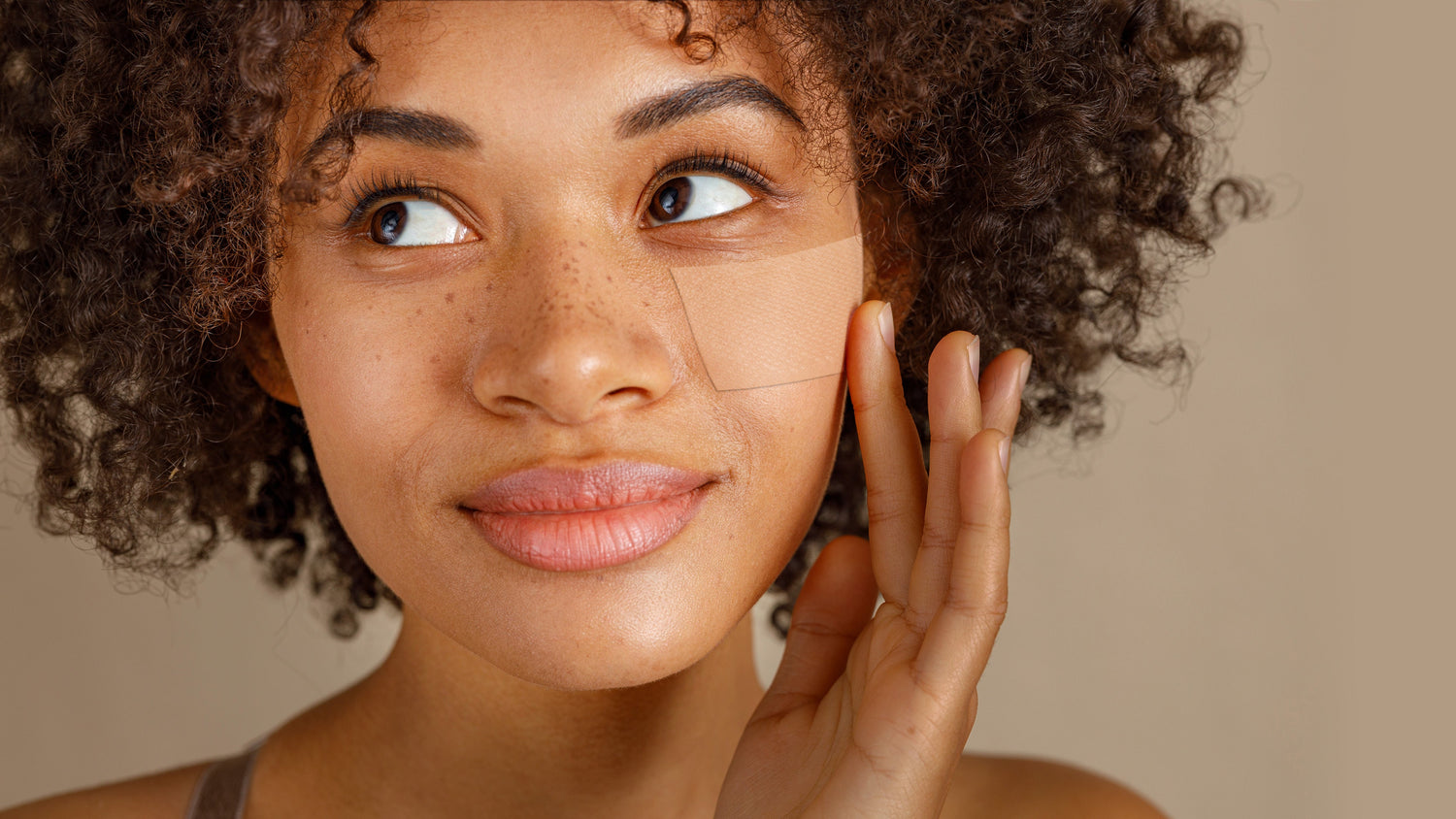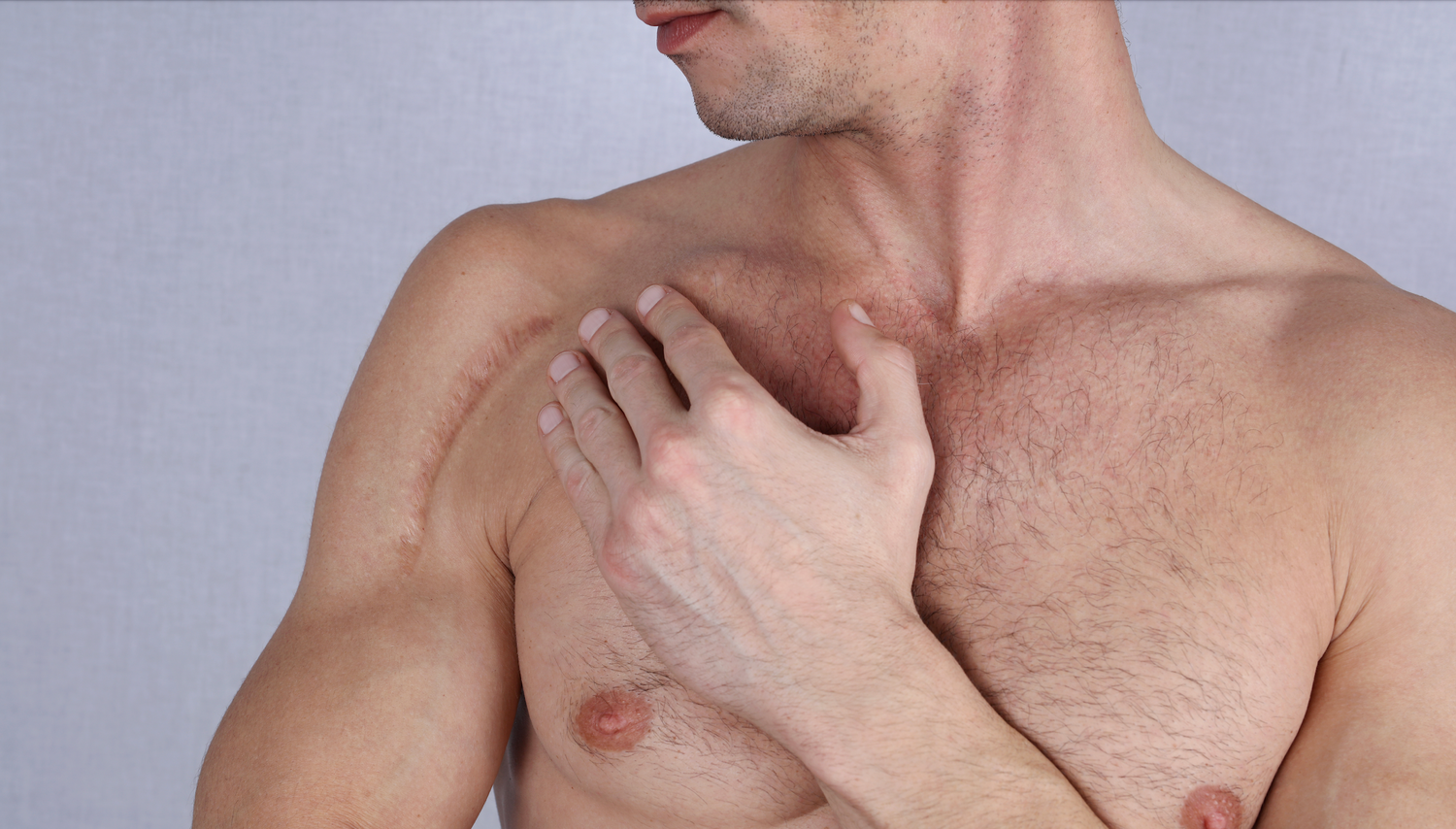If you're dealing with raised, thick keloid scars, you're not alone—and more importantly, you have options. Keloids affect millions of people worldwide, particularly those with darker skin tones, with studies showing occurrence rates as high as 16% in certain populations. These challenging raised scars extend beyond the original injury site, creating thick, elevated tissue that can cause both cosmetic concerns and emotional distress.
These raised scars grow larger than the injury that caused them and can take months to years to develop [1]. While keloids don't fade over time naturally [1][2], the encouraging news is that several clinically-demonstrated approaches can significantly reduce their appearance and associated symptoms, helping you regain confidence in your skin.
Understanding Keloid Scars: What Makes Them Different
Keloids are more than just ordinary scars—they're your body's overenthusiastic response to healing. Here's what sets them apart:
• Size: Keloids develop when scars keep growing and become bigger than the original wound, often due to excess collagen in the skin [2]
• Persistence: These scars present as firm, raised lesions that extend beyond the area of injury and do not improve on their own, often continuing to grow over time [3]
• Impact: They can cause pain, itching, stiffness, and emotional distress, all of which can affect quality of life [4]
• Demographics: The incidence of keloids in individuals with skin of color is as high as 16% [5]
The good news? You don't have to live with these raised scars forever. Modern scar care approaches offer real hope for reducing their appearance and restoring smoother-looking skin.
Comparing the 5 Best Keloid Scar Removal Methods
| Method | Invasiveness | Success Rate | Best For | Time to Results |
|---|---|---|---|---|
| Silicone Scar Sheets | Non-invasive | Significant improvement in 60% of cases [6] | All keloid types, first-line care | 2-4 months |
| Corticosteroid Injections | Minimally invasive | 50-100% regression rates [3] | Established keloids | 2-6 months |
| Laser Approaches | Minimally invasive | Significant improvement in color and height [7] | Discoloration and texture issues | 3-6 months |
| Cryotherapy | Minimally invasive | Best results with 3+ sessions [8] | Smaller keloids | 2-4 months |
| Surgical Excision + Care | Invasive | 87.5% success with combination approach [7] | Large, persistent keloids | 6-12 months |
1. Silicone Scar Sheets - The Gentle Gold Standard
Silicone gel sheeting has been an effective scar care method since 1980 and is considered the gold-standard, non-invasive approach for keloid scars [9]. This gentle method makes it an excellent starting point for anyone looking to reduce keloid appearance without medical procedures.
Nuvadermis Silicone Scar Sheets stand out in this category, being "The ONLY Brand with Scar Sheets for All Skin Tones" according to their brand presentation. This ensures everyone can find products that blend naturally with their complexion—a crucial consideration often overlooked by other brands.
The Science Made Simple
The science behind silicone scar care is fascinating yet straightforward. When applied to the scar, silicone attaches to the tissue and creates gentle tension on the skin's surface, encouraging the body to reduce excess collagen and support broken blood vessels [10]. Think of it as giving your skin the right environment to remodel itself naturally.
Impressive Clinical Results You Can Trust
Research consistently demonstrates encouraging outcomes:
- Studies report 86% reduction in texture, 84% in color, and 68% in height of scars [11]
- Clinical trials show scar color scores decreasing 1.2 points for hypertrophic scars and 0.9 points for keloids, with thickness and elasticity also improving significantly [6]
- Large prospective studies demonstrate significant improvement in color, thickness, and elasticity for keloid scars [6]
Your Simple Usage Guide
The beauty of silicone scar care lies in its simplicity:
- Clean and dry the keloid area
- Cut the sheet to fit your scar size
- Apply for 12 hours or more daily, with many people seeing results within two to four months [10]
- For optimal effectiveness, use for at least three months and minimum four hours daily [6]
According to the Nuvadermis brand presentation, their sheets offer 6-week application for new scars and 2-4 months for older scars. The products are dermatologist-approved and clinically-demonstrated for effectiveness. For those preferring flexibility, Nuvadermis Scar Tape provides the same premium medical-grade silicone in an easy-to-customize format.
2. Corticosteroid Injections - Professional Medical Care
The most common medical approach involves intralesional corticosteroid injections alone or combined with other methods, with triamcinolone acetonide being the most commonly used [3]. This professional approach requires working with a dermatologist but can provide significant results for stubborn keloids.
What to Realistically Expect
Response rates vary widely, showing 50–100% regression with recurrence rates of 33% after 1 year and 50% after 5 years [3]. Studies show triamcinolone acetonide injections can flatten 50 to 100 percent of keloids, with a 9 to 50 percent recurrence rate [7].
Your Care Journey
Professional keloid injection care typically involves:
- Injections every four to six weeks, usually limited to five total injections [10]
- Two or three initial injections given a month apart, with care potentially continuing for six months or longer [7]
- Regular monitoring and adjustment based on your response
Enhanced Results with Smart Combinations
Combination approaches using 5-fluorouracil and triamcinolone acetonide show superior effectiveness with fewer side effects compared to single methods [3]. Many dermatologists recommend pairing professional injections with at-home silicone care for comprehensive results. Products like Nuvadermis Advanced Scar Gel complement professional care beautifully with their retinol-infused formula.
3. Laser Approaches - Precision Technology for Better Results
Laser approaches can reduce keloid height and fade discoloration [8], offering precise targeting of scar tissue. Both ablative lasers (CO2, Er:YAG) and non-ablative lasers (Nd:YAG, pulsed-dye) can help, with different mechanisms for addressing various aspects of keloid appearance [12].
Encouraging Clinical Outcomes
Laser-addressed keloid areas showed significant improvement in redness, itching, and scar height compared with non-addressed portions, with improvements lasting at least six months [7]. Pulsed-dye laser care can ease itchiness and help keloids fade [13], making it particularly valuable for uncomfortable keloids.
Combination Approaches Deliver Superior Results
Better outcomes occur when combining CO2, pulsed-dye, or Nd:YAG lasers with triamcinolone acetonide injections [3]. Laser methods work best alongside other approaches like corticosteroid injections or pressure applications [8].
Post-laser care with quality silicone products can enhance and maintain results. The Nuvadermis Scar Care Duo combining scar sheets and gel provides comprehensive support during the healing phase.
4. Cryotherapy - Controlled Freezing for Smaller Keloids
Smaller keloids can be addressed using liquid nitrogen through cryotherapy, though this method can cause side effects including temporary blistering, discomfort, and changes in skin color [13]. This method works best for smaller keloids and requires professional administration.
Maximizing Effectiveness Through Strategic Combination
Cryotherapy often works best after keloid surgery, typically performed about two weeks after stitches are removed to help prevent new scar tissue formation. When combined with corticosteroid injections, cryotherapy may reduce keloid size, making subsequent injections more effective [8].
Optimal Care Frequency for Best Results
Dermatologists find that patients receiving three or more cryotherapy sessions tend to achieve the best outcomes [8], emphasizing the importance of following through with the complete care plan.
5. Surgical Excision with Comprehensive Follow-Up Care
Surgery may be recommended for keloid removal when other methods don't provide sufficient improvement, though up to 100% of keloid scars return after surgery alone [13]. The key to surgical success lies in combining removal with comprehensive follow-up care.
The Proven Triple Combination Approach
A "triple keloid care approach" combining surgery, corticosteroids, and silicone sheeting demonstrates remarkable effectiveness, with only a 12.5 percent recurrence rate after 13 months [7]. Currently, the most effective and safe approach for keloid management appears to involve corticosteroid injections after surgical excision [14].
Your Post-Surgical Success Strategy
Post-surgical care should include:
- Immediate corticosteroid injections
- Additional approaches like pressure garments or cryotherapy to reduce recurrence risk [8]
- High-quality silicone scar care for long-term maintenance
Using Nuvadermis Silicone Scar Sheets as part of your post-surgical routine can significantly improve outcomes and help prevent keloid recurrence. Their clinically-demonstrated effectiveness makes them an ideal choice for this critical healing phase.
Your Trusted Partner: Nuvadermis Keloid Care Solutions
When choosing products to support your keloid care journey, quality and expertise matter immensely. Nuvadermis understands the unique challenges of keloid scars and offers clinically-demonstrated, dermatologist-approved formulas designed specifically for challenging scars.
Complete Keloid Care System
Immediate Action Products:
- Silicone Scar Sheets: Premium medical-grade silicone specifically recommended for keloids, available in multiple skin tones
- Soft Silicone Scar Tape: Flexible option perfect for customizing to various keloid sizes and shapes
Enhanced Care Options:
- Advanced Scar Gel: Additional support featuring retinol and allantoin for comprehensive scar care
- Overnight Intensive Scar Cream: Intensive nighttime care for enhanced results
These science-backed skincare products deliver professional-grade results without requiring clinical procedures, making effective keloid care accessible for at-home use. You can explore complete scar care bundles that combine multiple approaches for enhanced results.
Your Path Forward: Combining the Best Keloid Scar Removal Methods
To achieve the best results, dermatologists often recommend combining multiple approaches for keloids, as using two or more care methods typically improves outcomes [8]. Combined approaches clearly outperform single methods, with isolated approaches showing inferior results compared to comprehensive care plans [15].
Starting Your Keloid Care Journey
Your keloid care journey doesn't have to feel overwhelming. Here's a practical approach:
Phase 1: Gentle Foundation (Weeks 1-12)
- Start with high-quality silicone sheets like Nuvadermis Scar Sheets
- Apply consistently for 12+ hours daily
- Monitor progress and document changes
Phase 2: Professional Enhancement (Months 3-6)
- Consult with a dermatologist about injection options
- Continue silicone care between professional sessions
- Consider adding Advanced Scar Gel for enhanced results
Phase 3: Long-term Maintenance
- Maintain silicone care routine
- Regular professional monitoring
- Adjust approach based on results
Remember, patience is crucial in scar care. Results take time, but with consistent use of quality products and professional guidance when needed, you can significantly reduce keloid appearance and restore confidence in your skin.
For more personalized guidance on caring for your scars, explore Nuvadermis's helpful article on 3 Ways to Care for Your Scars. Ready to start your keloid care journey? Visit nuvadermis.com to explore their complete line of scientifically-formulated scar care solutions designed to restore your confidence with smoother, healthier-looking skin.
Your scars don't define you—but taking action to care for them shows your commitment to feeling confident and comfortable in your own skin. With the right combination of these clinically-demonstrated methods and quality products, you can achieve the smoother, more confident appearance you deserve.
Citations
- https://my.clevelandclinic.org/health/diseases/keloid-scar
- https://www.nhs.uk/conditions/keloid-scars/
- https://pmc.ncbi.nlm.nih.gov/articles/PMC6063260/
- https://pmc.ncbi.nlm.nih.gov/articles/PMC8007468/
- https://journals.lww.com/prsgo/fulltext/2024/02000/dexamethasone_mesotherapy__an_alternative_for.47.aspx
- https://jcadonline.com/topical-silicone-sheet-application-in-the-treatment-of-hypertrophic-scars-and-keloids/
- https://www.aafp.org/pubs/afp/issues/2009/0801/p253.html
- https://www.aad.org/public/diseases/a-z/keloids-treatment
- https://en.wikipedia.org/wiki/Silicone_gel_sheeting
- https://nyulangone.org/conditions/scars-keloids/treatments/medical-treatment-for-scars-keloids
- https://pmc.ncbi.nlm.nih.gov/articles/PMC2918339/
- https://pmc.ncbi.nlm.nih.gov/articles/PMC11193462/
- https://www.webmd.com/skin-problems-and-treatments/what-are-treatments-for-keloid-scars
- https://pubmed.ncbi.nlm.nih.gov/18611924/
- https://www.sciencedirect.com/science/article/pii/S235258782100053X




